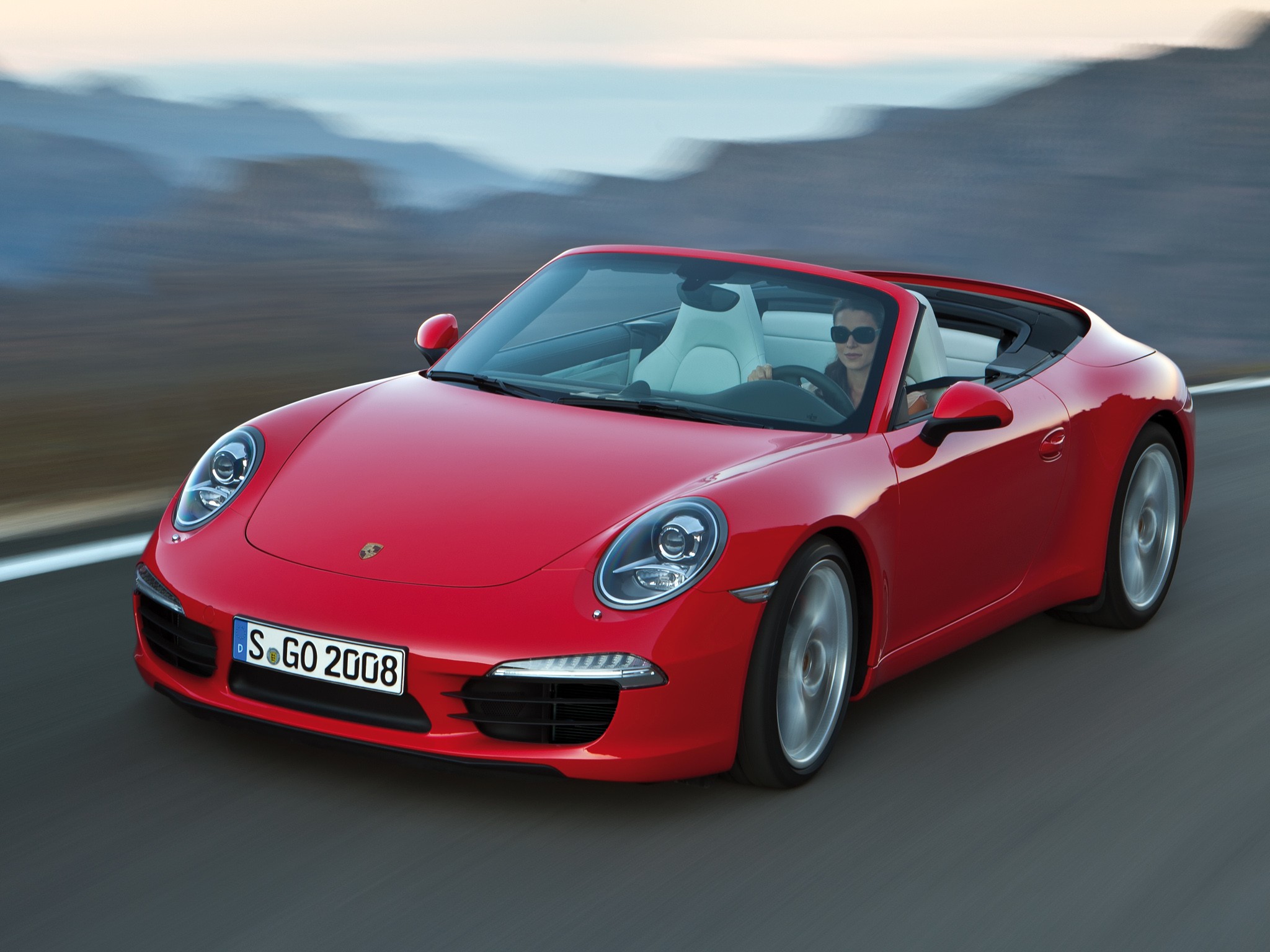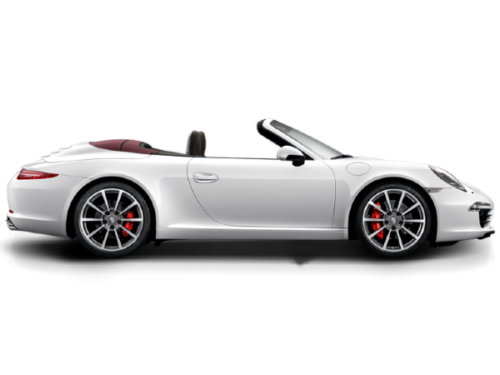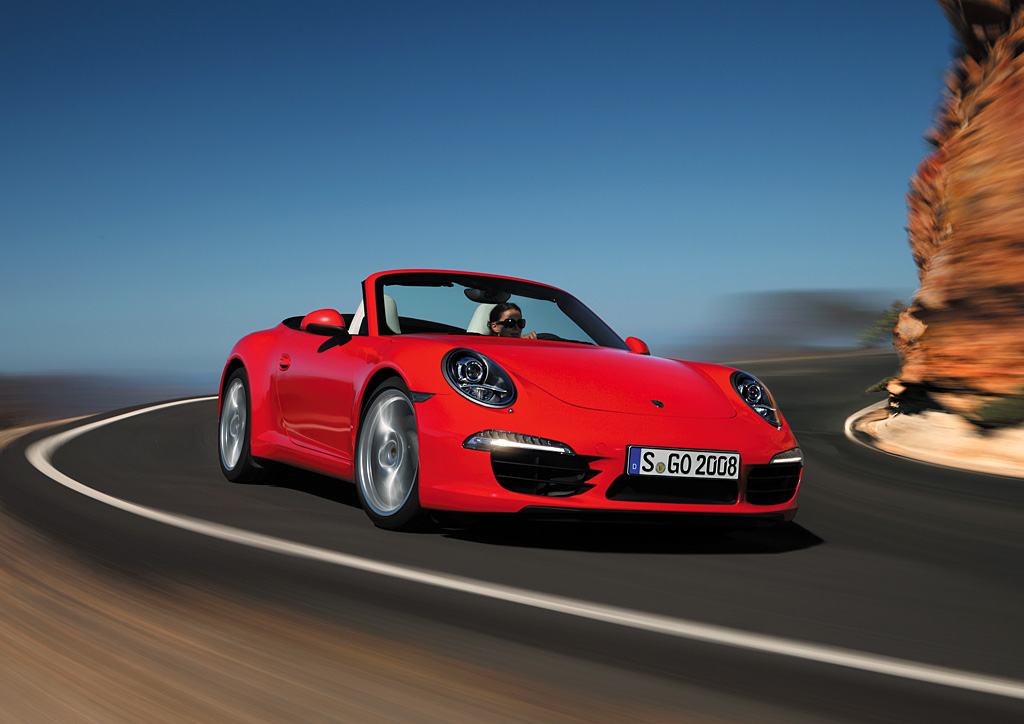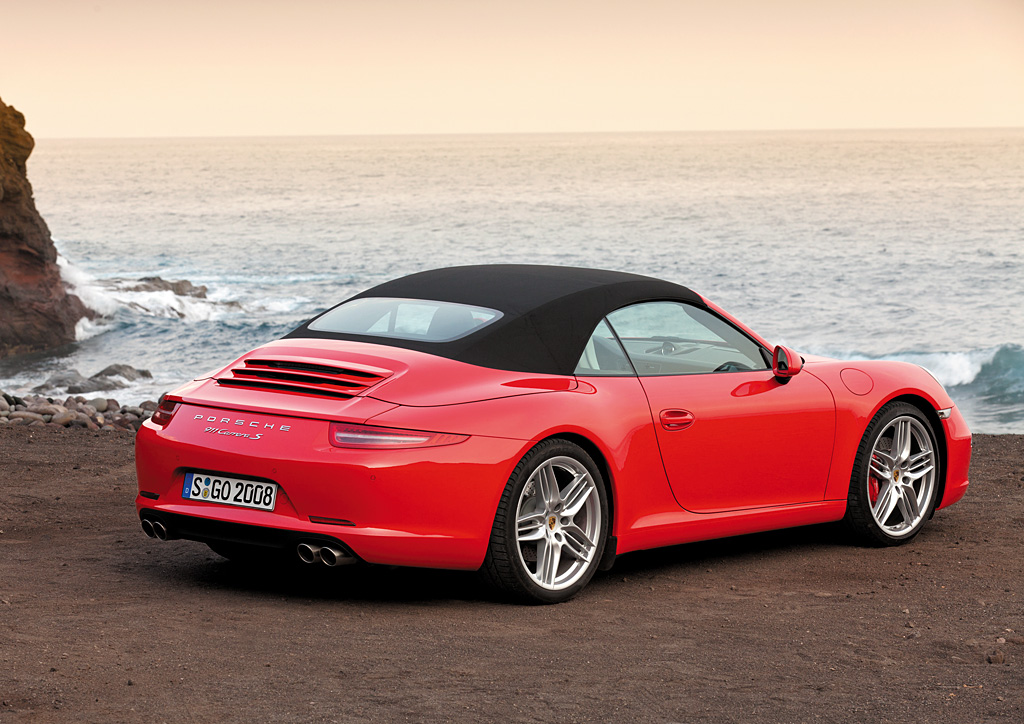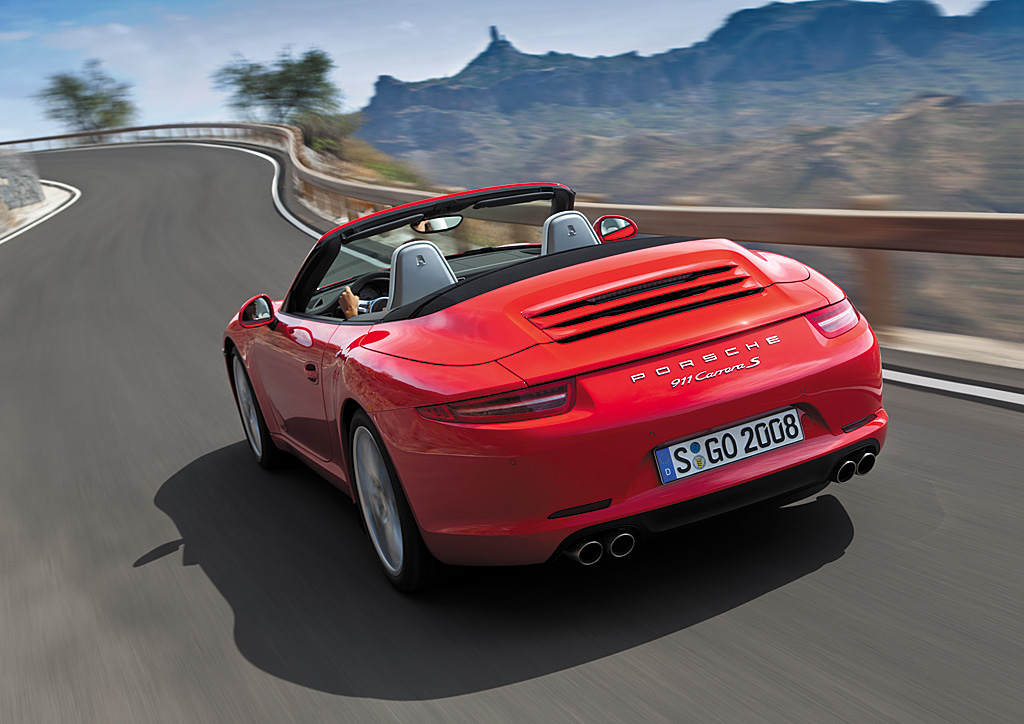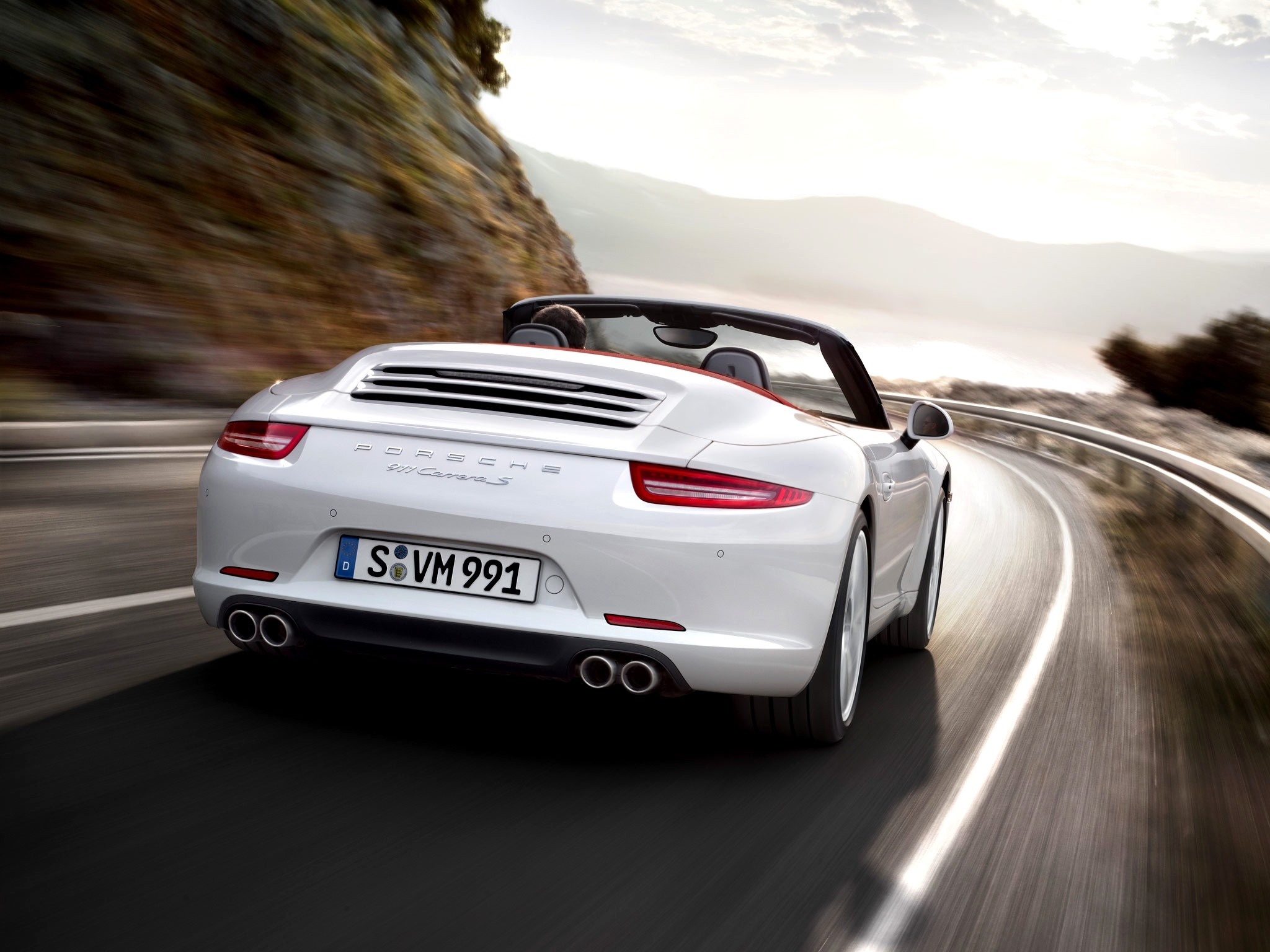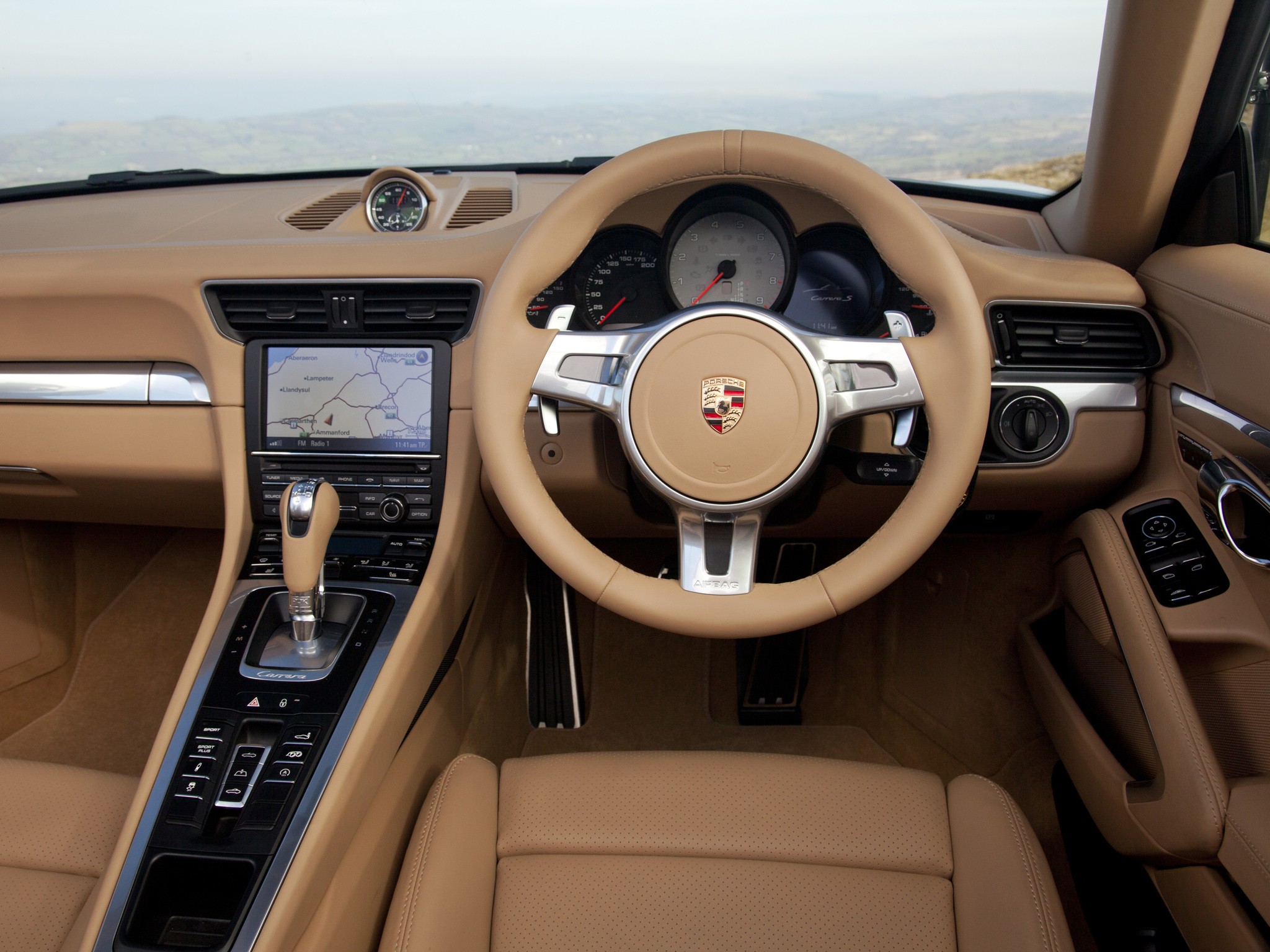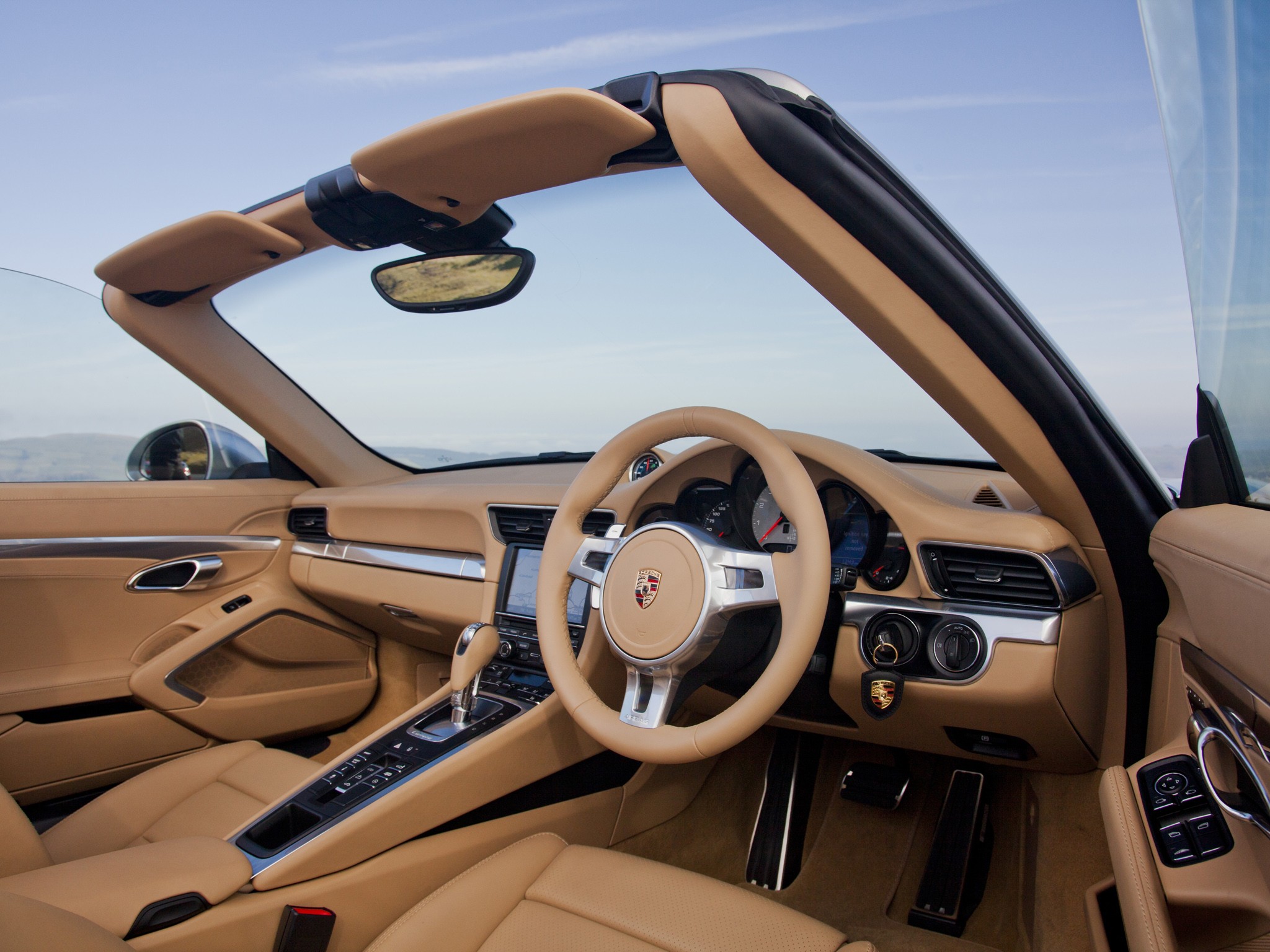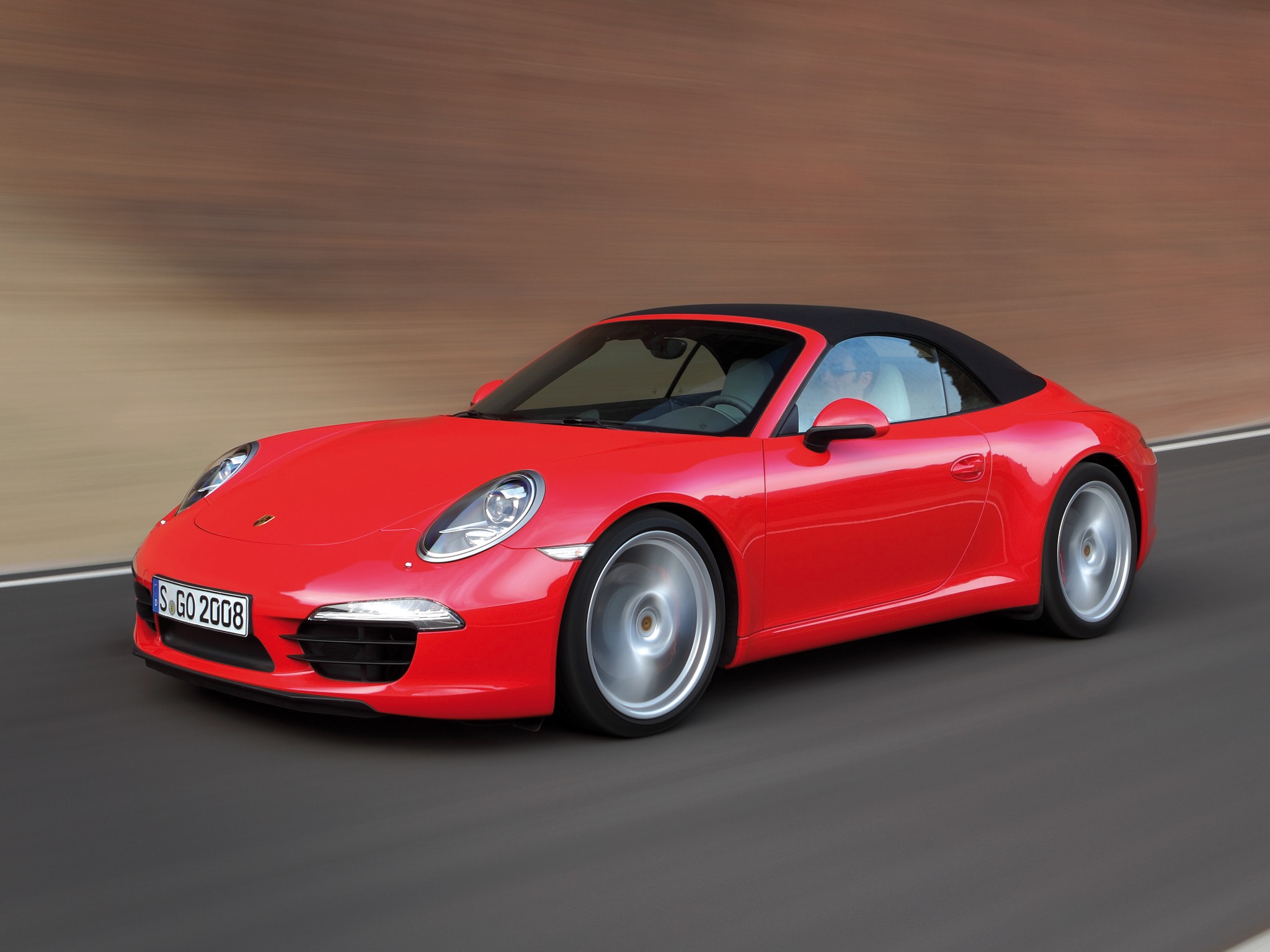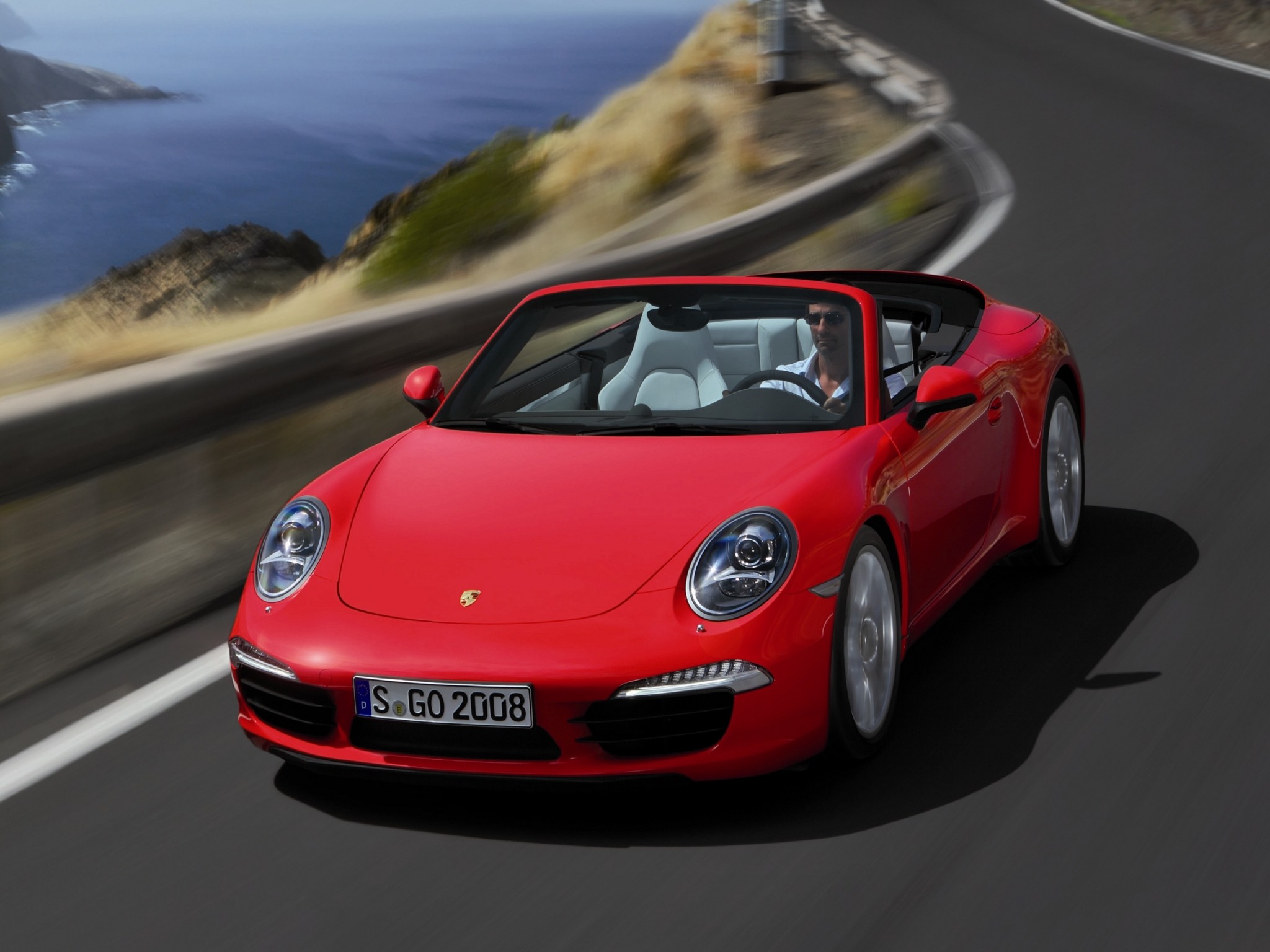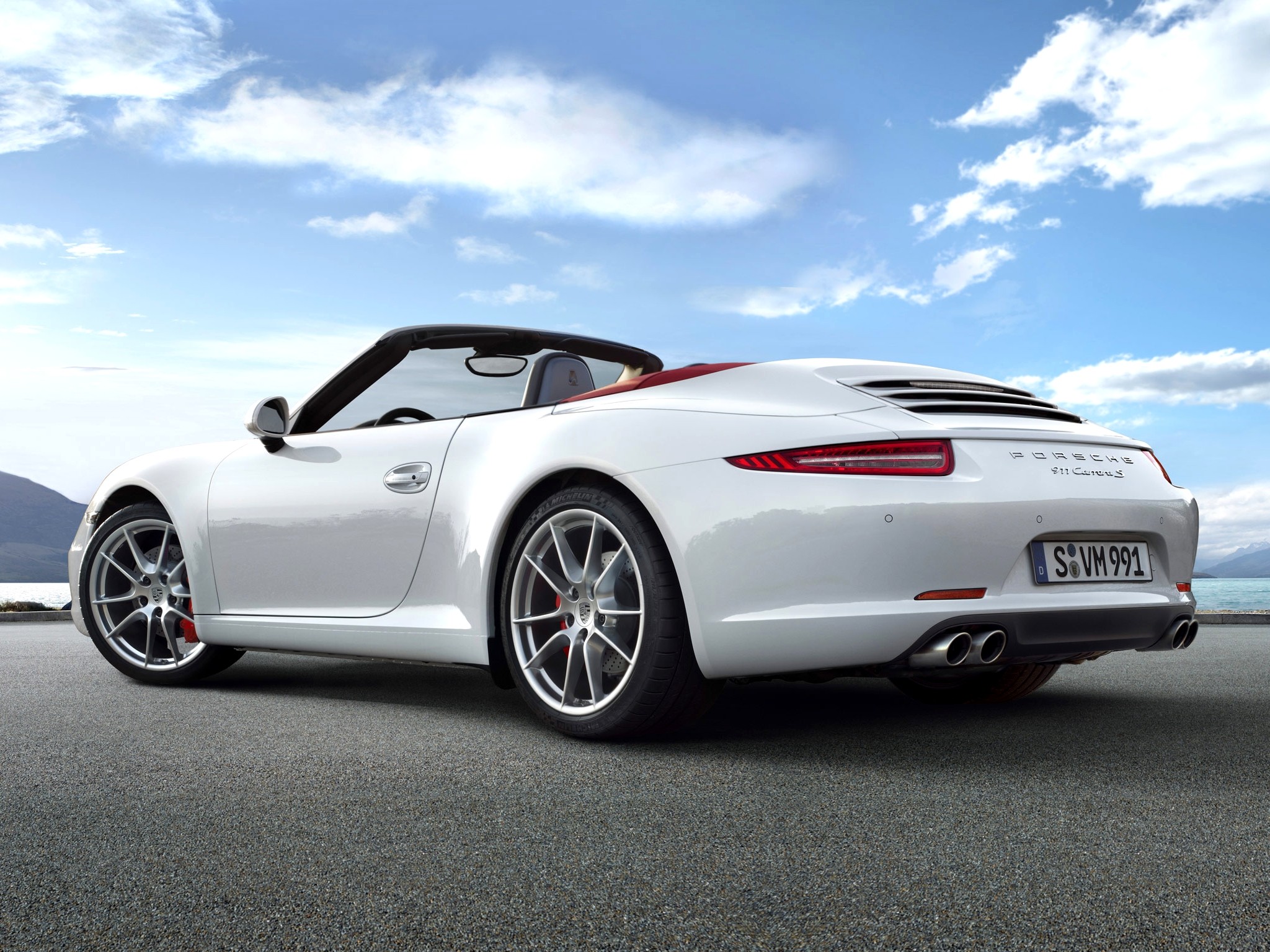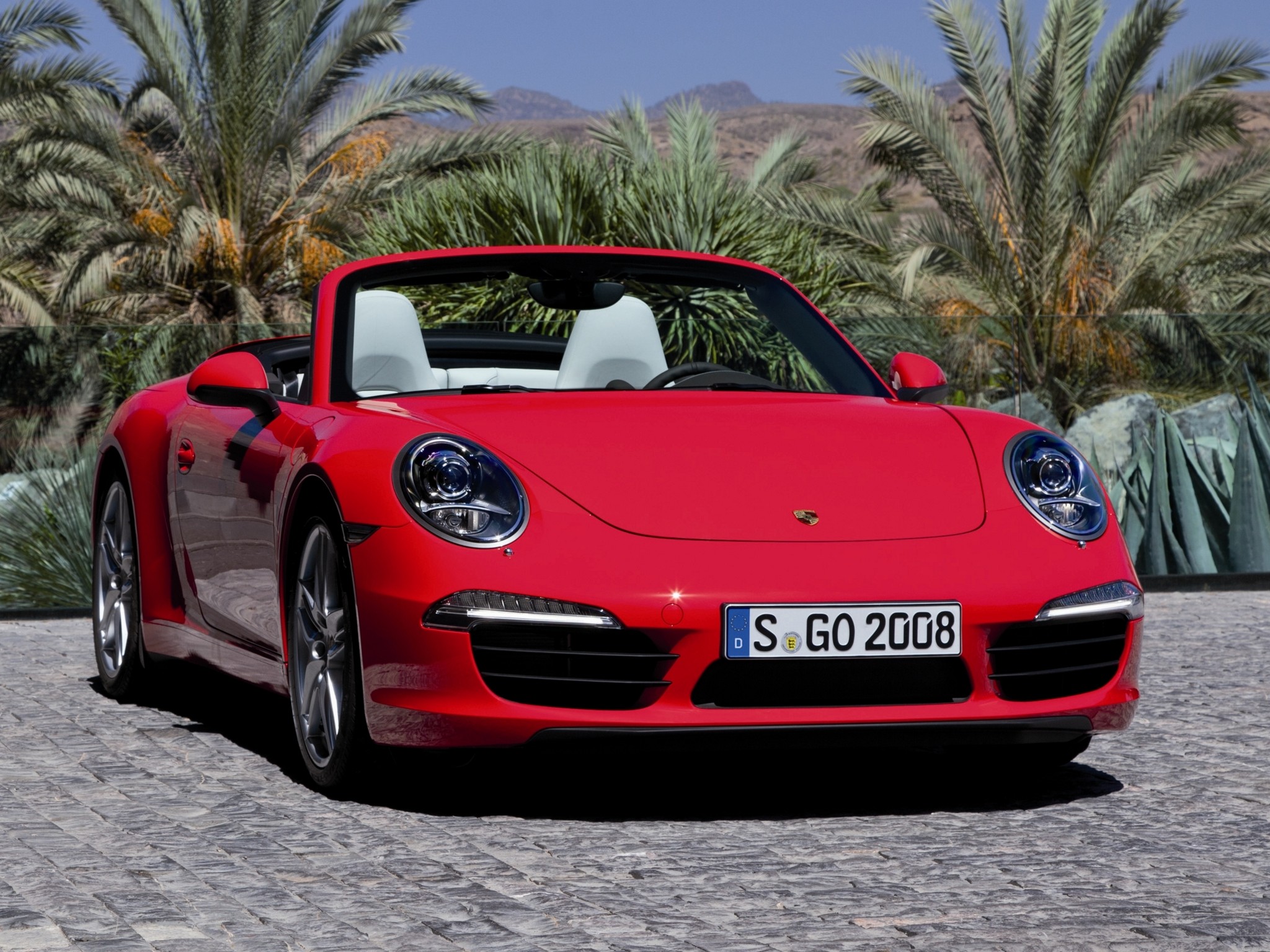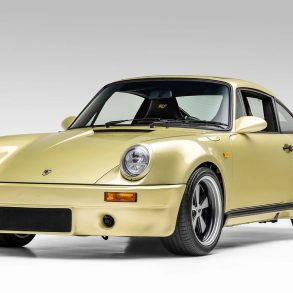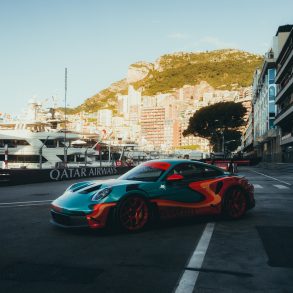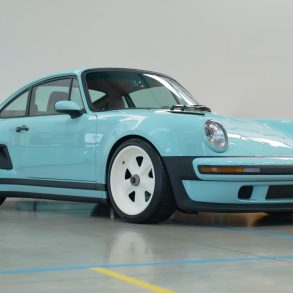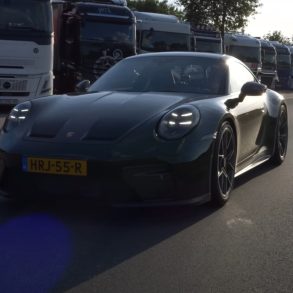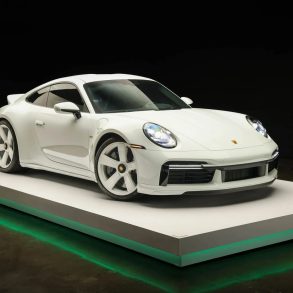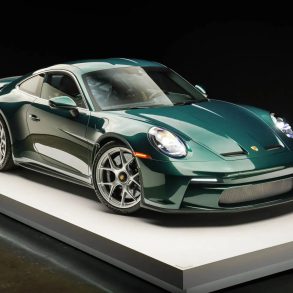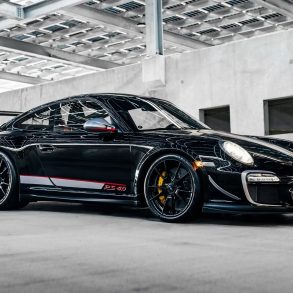(2012 – 2015) Porsche 911 Carrera S Cabriolet (991) – Ultimate Guide
What the Coupe began with the new aluminium-steel body, the Cabriolet continues with the all-new, unique hood: As a result, the typical 911 roof line is initially retained in its entirety. Even when closed up, the Cabriolet cuts a fine figure. Intelligent lightweight design, even including the use of magnesium in the hood, ensures less weight and more sportiness, lower fuel consumption and greater comfort. With the open-top 911s as well, Porsche has managed to reverse the weight spiral and make the new Cabrio models significantly lighter than its predecessors.
Each of the two new Cabriolets has the same engine as its Carrera Coupé equivalent. The open-top Carrera S comes with a 3.8-litre six-cylinder engine developing 400 hp (294 kW) and also a seven-gear manual transmission featured as standard. That means that the open-top 911s as well are distancing themselves even further from the competition in terms of efficiency; both models consume less than ten litres of fuel per 100 kilometres (NEDC). The Cabriolets as well have the Porsche Doppelkupplungsgetriebe (PDK) available as an optional extra, delivering even lower fuel consumption and shorter acceleration times.
Motortrend: …the 911 Carrera S Cabriolet is fabulous. Fabulous in a way that makes you think, “Yeah, I’d be satisfied with this for a long time.” Fabulous in a way that makes you make grand statements that you’ll probably regret later, like: This is one of the best sports cars on the market right now.
With the longer wheelbase compared with the predecessor model, the wider front track and the new electro-mechanical power steering, the new Cabriolets offer even sportier driving characteristics, greater precision and agility. Depending on model, there are other standard or optional active control systems available as well that further enhance the driving dynamics. Like the rest of the 991 generation, the Carrera S Cabriolet loses hydraulic steering, replaced instead with an electric set up that frankly works better for a convertible that is likely more a GT user case than a canyon carver.
Consider that, despite weighing 228 pounds more than the hardtop Carrera S, the Cabriolet is only negligibly slower. A figure-eight lap requires 24.3 seconds (0.2 second slower) and generates a 1.03 lateral g average, which ties the hardtop. The Cabriolet takes 0.1 second longer to reach 60 mph and the quarter mile (3.8 seconds and 12.1 seconds at 116 mph, respectively). The 911 remains, then, the only production car we’ve tested that, with 400 horsepower or less, can reach 60 mph in fewer than 4 seconds. Much of this performance we can attribute to the latest version of Porsche’s seven-speed twin clutch (the oh-so elegantly titled Porsche Doppelkupplungsgetriebe, or PDK). Launch control and its instantaneous shifts (with perfect rev matching) are great for test numbers, but PDK also offers drivers better flexibility and control over twisty mountain roads.
On mountain roads, the Carrera S is an encouraging car, such that the idea of driving it top-down in the rain seems smart. It’s something beyond the sum of 400 horsepower, superlative grip, and an exhaust that barks and burbles so sweetly. It’s more than the roof, which, at speeds up to 31 mph, retracts in 13 seconds. It’s more than the electric steering, which disappointingly lacks the liveliness and feedback of Porsches past, but remains as precise as ever. (Attention, Porsche: Please address this.)
Car and Driver: Beyond its outer cloth layer (available in four colors, natch), this piece shares little with a traditional convertible top. Hidden beneath the cloth are more hard materials than soft, including three cast magnesium panels that stretch from window to window and windshield to magnesium-framed rear glass. Combined with the aluminum and magnesium hinges, the panels make the roof nearly impenetrable to thieves—a common worry with traditional cloth roofs. …Operation can occur at speeds of up to 31 mph. The redesigned top doesn’t add weight (coming in at 79 pounds, the same as the previous-gen 997’s) or frumpiness, as the top-up silhouette is identical to the coupe’s.
Launch Video
Pictures
Press Release
With the Porsche 911 Carrera S Cabriolet, Dr. Ing. h.c. F. Porsche AG, Stuttgart, is doubling the driving fun to be had from the new 911 Carrera by putting a Cabriolet alongside the Coupé. The debut of the new generation of the sports car classic is being followed only a few months later by the open-top models of the 911 Carrera and 911 Carrera S in the new 911 design.
What the Coupé began with the new aluminium-steel body, the Cabriolet continues with the all-new, unique hood: As a result, the typical 911 roof line is initially retained in its entirety. Even when closed up, the Cabriolet cuts a fine figure. Intelligent lightweight design, even including the use of magnesium in the hood, ensures less weight and more sportiness, lower fuel consumption and greater comfort. With the open-top 911s as well, Porsche has managed to reverse the weight spiral and make the new Cabrio models significantly lighter than its predecessors.
Each of the two new Cabriolets has the same engine as its Carrera Coupé equivalent. The rear of the 911 Carrera Cabrio houses a 3.4-litre flat engine generating 350 hp (257 kW) of power driving the rear wheels through a seven-gear manual transmission. The open-top Porsche 911 Carrera S Cabriolet comes with a 3.8-litre six-cylinder engine developing 400 hp (294 kW) and also a seven-gear manual transmission featured as standard. That means that the open-top 911s as well are distancing themselves even further from the competition in terms of efficiency; both models consume less than ten litres of fuel per 100 kilometres (NEDC). The Cabriolets as well have the Porsche Doppelkupplungsgetriebe (PDK) available as an optional extra, delivering even lower fuel consumption and shorter acceleration times.
With the longer wheelbase compared with the predecessor model, the wider front track and the new electro-mechanical power steering, the new Cabriolets offer even sportier driving characteristics, greater precision and agility. Depending on model, there are other standard or optional active control systems available as well that further enhance the driving dynamics.
The 911 Carrera Cabriolet will be launched in Germany on March 3, 2012. The prices for the Porsche 911 Carrera Cabriolet start in Germany with 100,532 Euros, the Porsche 911 Carrera S Cabriolet starts with 114,931 Euros including value-added tax in both cases.
Open-top lightweight 911 with new design language
The new Porsche 911 Carrera Cabriolet’s design echoes its predecessor’s styling while developing an entirely new design language: thanks to a longer wheelbase combined with shorter overhangs, the vehicle makes a compact, made to measure impression. A vehicle height reduced by a further four millimetres (three millimetres in the case of the 911 Carrera S) compared with the 911 Carrera Coupé strikes a distinctly sporty tone in outward appearance.
As a result of the 52 millimetre wider front track compared with the predecessor, the new 911 Carrera Cabriolet has an even more solid stance on the road. The vehicle’s 61 millimetre greater width at the front creates an even more harmonious vehicle silhouette. Larger air intakes underneath the redeveloped front lights emphasise the striking appearance. Together with the new Bi-Xenon headlights, they give the new Porsche 911 Carrera Cabriolet a distinctive face.
The rear end echoes the sporty looks of the car’s front end. It is characterised in particular by the new wider rear spoiler below the engine lid air intakes. The outer edge of the lid is part of the continuous design edge, which cleverly emphasises the vehicle’s width. The compact dimensions of the redeveloped top system when stowed enabled the space above the engine to be used to best effect. The result: an elegantly flat and harmonious rear section.
Body: even stiffer and up to 60 kilograms lighter
The innovative lightweight-body of the 911 Carrera family was redesigned from the ground up for Coupé and Cabriolet alike. That means that the open-top 911 and fixed-roof model share both the weight advantages of the aluminium-steel body and the significantly improved rigidity, complemented by local reinforcement elements. It was possible to improve dynamic torsional rigidity, which has a critical influence on comfort, by 18 per cent in the new Porsche 911 Carrera Cabriolet models. Notwithstanding the 911 Carrera Cabriolet’s increased dimensions, all the measures as a whole have yielded significant weight reductions compared with the predecessor models.
Refined ambiance with numerous customisation options
The open-top 911 Carrera models’ interior equipment largely follows the interior concept of the Coupé. As before, a central design element is the centre console rising up to the front. It ensures improved ergonomics by closer integration of driver and front passenger.
The new operating concept makes controlling the vehicle’s central functions uncomplicated and intuitive. The new Cabriolets also offer greater comfort in the rear. For example, the shorter installation length of the new roll-over protection system creates more legroom compared with the predecessor model.
The dashboard is classically laid out. The 911’s trademark five round instruments provide all the important information about the vehicle’s operating state. The new 4.8-inch, high-resolution, TFT colour screen in the instrument cluster to the right of the rev counter contains extensive configurable display options for vehicle status, audio, telephone, navigation, map display, on-board computer and tyre pressure monitoring. With the optional Sport Chrono Package, a so-called G-Force display for showing longitudinal and lateral acceleration can be accessed on the multi-function screen. Vehicles with manual transmission also feature a shift assistant display for performance-optimised driving. The driving light assistant featured as standard automatically switches from daytime running lights to dipped beam as dusk falls and, for example, when traversing tunnels.
Sports seat system with greater range of adjustment as standard
The Porsche 911 Carrera Cabriolet’s interior is rounded off by the sports seat system, featured as standard, with electrically adjustable backrest angle and height. Over and above the standard seat functionality, the optional sports seats with fully-electrical 14-way adjustment offer electrically-powered fore and aft adjustment, seat cushion angle, seat cushion height adjustment and four-way lumbar adjustment. The 18-way Adaptive Sports Seats Plus and prominent seat bolsters, also available as an option, feature additional adjustment of the seat cushion and seat back bolsters for optimal side support in any driving situation. Both versions include the Memory Package and electrical steering column adjustment. In conjunction with optional heated seats, seat ventilation is available for all sports seat versions.
Sound Package Plus featured as standard, top-of-the-range sound systems from Burmester® and BOSE® upon request
The new CDR-31 audio system, combined with the Sound Package Plus, featured as standard, provides acoustic information and entertainment. Porsche has teamed up with Burmester® to develop a special system for the 911 Carrera as the top-of-the-range sound system offering. The experience of the multiple prize-winning systems in the Panamera and Cayenne has been harnessed to achieve total output and sound quality unprecedented in the sports car segment. The system comprises twelve individually controllable loudspeakers, including an active so-called subwoofer built into the bodyshell with 140 millimetre speaker diameter and integrated 300 watt Class D output stage; complemented by 12 amplifier channels with a total output of more than 800 watts.
The BOSE® Surround Sound System continues to be offered as an option. It also features twelve loudspeakers, including a 100 watt active subwoofer built into the bodyshell with Class D output stage and 200 millimetre speaker diameter as well as eight amplifier channels, ensuring an impressive aural experience. This delivers an overall output of 445 watts.
Innovative lightweight roof with Coupé characteristics
The attention-getter with the 911 Carrera Cabriolet is the unique and all-new panel bow top. Thanks to the innovative technology, it has been possible for the first time to achieve the previously unachievable Coupé-like roof curvature of the closed top, which offers aerodynamic advantages into the bargain. Moreover, the weight of the entire top remains on a par with the predecessor model, notwithstanding the increased length and significantly enhanced comfort.
The top can be opened and closed in approximately 30 seconds respectively – as in the case of the predecessor up to a speed of 50 km/h. It is operated by means of a button on the centre console or, from the outside, by means of the remote control.
Porsche has traditionally set the highest standards for the 911 top. That is why the new folding roof as well – as with every previous 911 – is a completely standalone development. The first distinctive feature is apparent at a glance: the fabric roof is tensioned in an elegant arc from the front window frame to the convertible top compartment with styling that is almost identical to that of the Coupé. No roof bows are discernible under the fabric nor are there any sections that interrupt the flowing design. Even the heatable rear window is virtually flush-fitting thanks to a new technique and is integrated with the cover with only the most discreet of seams.
Porsche new development: Lightweight magnesium panel bow top
Critical to this shape, previously unachievable with fabric tops, is the innovative design as a panel bow top. This entails the entire fabric top – with the exception of the side panels – being tensioned over a rigid roof surface comprising four directly abutting individual segments. The four elements are the front roof frame, two panel bows and the rear window, the frame of which is made of magnesium, like the other segments.
With the top closed, the occupants enjoy a level of climate and noise comfort that comes closer to that of the Coupé than ever before. For example, the exterior material is underlaid over its entire area with an insulating mat. On the inside, the roof segments are covered with dimensionally stable roof linings that convey a comfortable interior feeling. The side panels as well are entirely clad with fabric so that with the hood closed, no technical components are visible any longer. The headroom as well is also broadly the same as inside the Coupé.
New: Fully integrated electric wind deflector
A further innovation in the Porsche 911 Carrera Cabriolet is the built-in electric wind deflector. That makes fitting and removal a thing of the past. The new wind deflector is attached to a U-shaped tensioning bracket, which is fully integrated into the rear area when retracted, thereby not encroaching on the available space on the rear seats. At the push of a button, this bracket deploys within two seconds, in the process unrolling a mesh that is tensioned at right angles by a second movable deflection bracket behind the front seat armrests. The wind deflector can be deployed up to a speed of 120 km/h.
Sportier, more comfortable suspension
The complete redesign of the suspension has a knock-on effect on the new 911 Carrera Cabriolet’s sportiness and comfort as well. In both models, the 100 millimetres longer wheelbase ensures significantly greater driving stability at high speed.
The wider front track width, 46 millimetres for the 911 Carrera Cabriolet and 52 millimetres for the 911 Carrera S Cabriolet, further improves driving stability and agility when cornering. In addition – depending on model featured as standard or as an optional extra – the enhanced Porsche Active Suspension Management (PASM), the new Porsche Dynamic Chassis Control, the completely revamped electro-mechanical power steering, Porsche Torque Vectoring (PTV), the modified braking system and new wheels and tyres ensure driving performance of the highest order.
Electro-mechanical steering with Porsche’s trademark precision and feedback
The new 911 Carrera generation sees Porsche’s first use of electro-mechanical power steering, which is vastly superior to every other system on the market in terms of its efficiency and precision. The fundamental advantage compared with hydraulic power steering is the reduction in fuel consumption by at least 0.1 l/100 km. Additional new functions further enhance comfort and safety. Specific feedback is passed to the driver through the steering wheel and negative or unnecessary influences are filtered out.
Faster and safer cornering: Porsche Torque Vectoring
In the new 911, Porsche Torque Vectoring (PTV) ensures yet greater agility, featured as standard in the open-top 911 Carrera S and available as an optional extra for the Porsche 911 Carrera Cabriolet. The system is available in two versions: the PTV version with mechanical differential lock when twinned with manual transmission and in PDK vehicles as PTV Plus with electronically controlled, fully variable differential lock. In a nutshell, PTV/PTV Plus improves the vehicle’s steering behaviour and precision by means of precisely modulated braking interventions on the inside rear wheel when being driven in a highly dynamic style.
Option: Sport Chrono Package accentuates all sporty 911 characteristics
All new 911 Carrera models feature a Sport button as standard. It enables the driver to choose between more comfortable or fuel-efficient tuning and a sportier setup. The optional Sport Chrono Package with additional Sport Plus button makes for an even wider spread between a sporty setup and driving comfort in everyday use. In addition to refining all the relevant systems and functions for maximum performance, for the first time the Sport Chrono Package features controlled, dynamic engine mounts. The magneto-rheological engine mounts have been enhanced based on the technology introduced in the 911 GT3 and optimised for the new 911 Carrera.
Top performance courtesy of Porsche Dynamic Chassis Control
A critical contribution to the impressive performance enhancement of the new 911 generation is made by Porsche Dynamic Chassis Control (PDCC), available as an option for the 911 Carrera S. Equipped with this system, the open-top model as well achieves a new level of lateral acceleration and handling. The vehicle’s lateral inclination, for example when entering a bend, when cornering and changing lanes at speed is almost completely offset by the variable stabiliser system up to the maximum lateral acceleration.
Porsche Intelligent Performance: more power, exemplary low fuel consumption
The production models of the open-top 911 traditionally have the same engines as the Coupés. This has not changed with the new generation. But in return the differences with the predecessor models have become all the greater: developed in accordance with the principle of Porsche Intelligent Performance, fuel consumption fell and output increased.
Courtesy of enhancements within the engine itself, accompanied by the new functions thermal management, on-board electrical system recuperation and auto start/stop function, the new models are up to 15 per cent more economical and up to 15 hp more powerful. In short: even as a Cabriolet, the 911 Carrera remains, by an even greater margin, the benchmark for efficient performance among premium sports cars.
Intelligent efficiency: Electrical system recuperation, thermal management, coasting
To increase efficiency, the boxer engines feature electrical system recuperation and map-controlled cooling water thermal management.These measures alone reduce fuel consumption based on the NEDC by 0.45 l/100 km. But it doesn’t stop there: Porsche is introducing the auto start/stop function for all transmission variants in the new 911 Carrera generation – including for the manual transmission. The occasional short interruptions are having a big effect: the automatic engine cut-off when the vehicle is stationary is saving 0.6 litres of fuel for each 100 kilometres driven based on the NEDC.
The principle of only drawing on engine power when it is actually needed has resulted in a new sports car function in the new 911 Carrera with PDK transmission: coasting. In principle, coasting is nothing other than the car rolling along without power, and as a result you can achieve fuel consumption for a limited distance equivalent to when the engine is idling. In practice that means fuel savings of up to one litre per 100 kilometres with a forward-thinking driving style in everyday driving.
Sound Symposer for even more intense acoustic driving fun
The new Porsche 911 Carrera generation offers the driver even sportier driving pleasure, sound-wise as well. And that not just with the top down: the Sound Symposer, featured as standard in both models, ensures an even meatier and sportier engine sound in the interior and is controlled by means of the Sport button, featured as standard.
Technical Specification
- Porsche 911 Carrera Cabriolet: 3.4-litre boxer engine with 350 hp (257 kW); rear-wheel drive, seven-speed manual transmission, optional seven-speed Porsche-Doppelkupplungsgetriebe (PDK); acceleration 0 – 100 km/h in 5.0 seconds, with PDK in 4.8 seconds (4.6 seconds with Sport Chrono Package); top speed 286 km/h, with PDK 284 km/h; fuel consumption (NEDC) 9.2 l/100 km, CO2 217 g/km; with PDK 8.4 l/100 km CO2 198 g/km.
- Porsche 911 Carrera S Cabriolet: 3.8-litre boxer engine with 400 hp (294 kW); rear-wheel drive, seven-speed manual transmission, optional seven-speed Porsche-Doppelkupplungsgetriebe (PDK); acceleration 0 – 100 km/h in 4.7 seconds, with PDK in 4.5 seconds (4.3 seconds with Sport Chrono Package); top speed 301 km/h, with PDK 299 km/h; fuel consumption (NEDC) 9.7 l/100 km, CO2 229 g/km; with PDK 8.9 l/100 km CO2 210 g/km.


